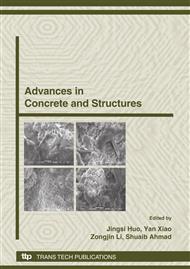p.287
p.295
p.301
p.311
p.321
p.329
p.335
p.341
p.347
The Numerical Study on Load-Transferring Model for SFRC Double-Column Combined Six-Pile Caps
Abstract:
For discussing the mechanism of load-transferring for reinforced steel fiber reinforced concrete (SFRC) double-column combined six-pile caps, the large-scale general finite element software-ABAQUS is used for the tested SFRC caps with computing in the aspects of modeling, cracking load, limit load, load-deformation curve, distribution of stress in caps and cracks and etc. The results of computing is compared with the result of experiments and the comparison is indicated: The results of computing and experiments are coincided well; The destroy pattern of SFRC double-column combined six-pile caps is sheared damage or punched damage and the model of load-transferring accords with spatial strut-and-tie method (STM); The mixture of steel fiber can improve cracking load and limit load for RC caps, delay the crack for caps, block the cracks’ expansion, and enhance the cap’s ductility.
Info:
Periodical:
Pages:
321-327
Citation:
Online since:
October 2008
Authors:
Price:
Сopyright:
© 2009 Trans Tech Publications Ltd. All Rights Reserved
Share:
Citation:


